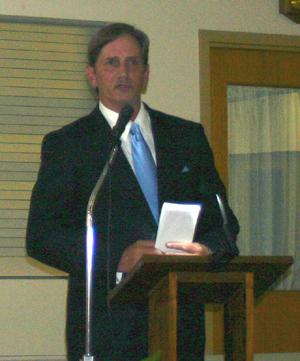
By Celine Klosterman
MUSCATINE — Michael Clancy calls himself a shy man who never wanted to find himself in the pro-life movement’s spotlight.
But if he didn’t keep his story alive, he wondered, who would?
So he told about 120 people in Muscatine May 15 how he came to take a now-famous photo of an in-utero baby’s hand grasping a surgeon’s finger, and described the controversy and pro-life victories that followed. He also touched on his own spiritual journey during his talk in Gannon Hall at St. Mathias Church, which he said was about the 60th place he’d spoken at in three years.
Faith and photojournalism first intertwined for Clancy in 1999, when the freelance photographer was assigned to capture images at a Pentecostal church for The Tennessean newspaper in Nashville. While at the church, the minister asked Clancy about the photographer’s faith. “I’d never opened a Bible,” Clancy said. Moreover, he told the minister he felt hopeless — largely because he was struggling with the aftermath of years of sexual abuse from his alcoholic stepfather.
The minister told Clancy he’d have to forgive. Clancy resisted, thinking the task would be too hard. But later, as he thought about his stepfather while driving home after a church service, he began to cry and pray. He pulled over, and while on the side of the road, found forgiveness. “I found our Lord and Savior,” he said. “I was absolutely set free for the first time in my life.”
Three months later, Clancy took another photo assignment that would change his life.
He agreed to photograph for USA Today a spina bifida corrective procedure to be performed on a 21-week-old fetus at Vanderbilt University Medical Center in Nashville.
In the operating room, the uterus of mother-to-be Julie Armas was lifted out. Later, Clancy saw it shake, though nothing outside it seemed to be moving it. Suddenly, an arm of unborn Samuel Armas flailed out, then retreated so only the hand showed. Clancy said surgeon Joseph Bruner then lifted the tiny hand, which gripped Bruner’s finger long enough for the photographer to capture four shots.
“I was shocked.” Clancy told a nearby nurse the baby had reached out. “Oh, they do that all the time,” he recalled her saying.
He soon sent his film to a USA Today photo editor. “It’s the most incredible picture I’ve ever seen,” the editor later said of Clancy’s best shot, the photographer recalled. And on Sept. 7, 1999, the national paper and The Tennessean published his photo — with Clancy’s caption saying the baby had reached out on its own.
But not everyone wanted the picture. Life Magazine, Clancy later discovered, had already posed a similar photo with Bruner that the magazine planned to publish on its cover in December. And Life wanted to buy his photo so the publication could “kill it,” he said a photo agency told him.
So Clancy raced to further publicize his photo before December. With a photo agency’s help, the photo and story of the surgery made it into newspapers and magazines across Europe by mid-November.
In December, Life published its story “Born Twice” in the magazine’s last several pages.
But Clancy was about to face another challenge. In a January 2000 story about his photo in The Tennessean, Bruner said, “Depending on your political point of view, this is either Samuel Armas reaching out of the uterus and touching the finger of a fellow human, or it’s me pulling his hand out of the uterus … which is what I did.”
Samuel was anesthetized and couldn’t move, Bruner later told USA Today.
Clancy said he then lost credibility and found it harder to find freelance work. And in 2006, The Tennessean told him it would no longer hire him because he’d been speaking out against abortion, he said.
Clancy did so most publicly in 2003, when he and the Armas family testified on the floor of the U.S. Senate during debate over partial-birth abortion. The procedure was later banned. Saying Clancy’s photo had been influential, the White House invited him to witness President George W. Bush sign the ban.
Clancy also told his Muscatine audience of the photo’s effect on him. Before taking the picture, the photographer’s sympathy for women with unplanned pregnancies made him pro-choice, he told his Muscatine audience. “But after witnessing Samuel’s struggle inside the womb, there is no doubt in my mind” that unborn babies are truly alive and deserve protection, he said.
Clancy’s become an outlet for people suffering post-abortion. He said he’s gotten e-mails from people as young as 12 and middle-aged men who realized they paid for the abortion of the only child they would’ve had.
He’s also heard from people who argue he has no right to oppose abortion because he’s a man. E-mails of thanks and good wishes continue, though.
Clancy’s photo “offers visual proof that might otherwise be left out of the abortion debate,” said Andrew Rauenbuehler, 17. He recently stepped down as director of Muscatine Right to Life and introduced Clancy’s talk.
You can’t deny evidence of an unborn baby’s humanity when Clancy’s photo is in front of you, said Hannah Flanders, 18. She helped bring the photographer to Muscatine after hearing from friends who heard him speak at a Nebraska March for Life. Clancy’s photo and talk “really impacted me.”








